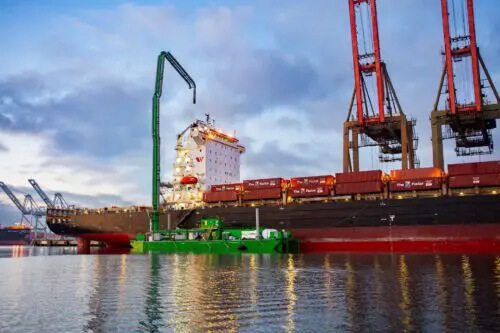Tankers to Use Funnel Caps to Filter Emissions at Shell’s LA Terminal

To meet California’s pending emissions regulations for vessels on berth, tankers docking at Shell’s Mormon Island Terminal in the Port of Los Angeles will be using an emission capture and filter system based on movable barges. STAX Engineering has signed a first-of-its-kind agreement with Equillon Enterprises which operates as Shell Oil Products US.
Starting in January 2025, the new California Air Resources Board (CARB) emissions regulations go into effect. They are expanding the requirement for on-berth vessels to either use shore power or capture their emissions to reduce pollution in the air in and around the ports of Los Angeles and Long Beach. It includes tankers as well as expanding to car carriers and other commercial vessels and will by 2027 expand to all California ports. CARB is also introducing regulations to reduce the emissions from harbor craft.
STAX Engineering launched in January 2024 and is based on a filtration system installed on barges for the ports as well as land-based, mobile solutions. The system places a cap above the funnel permitting vessels to continue to use their generators while docked without costly modifications. STAX reports that its system removes 99 percent of particulate matter (PM) and 95 percent of oxides of nitrogen (NOx) from exhausts funneled into its system before the exhaust is released as purified gas.

Emissions filters are mobile on the barge and work by cover the funnel (STAX)
The company has a five-year agreement to provide its service at the Mormon Island Terminal, which is a satellite of Shell’s Carson Terminal. The facility covers more than 400 acres and operates as a distribution facility by receiving and distributing fuels throughout the Southern California region via pipeline and truck delivery. Carson Terminal, which is also one of the oldest in Southern California dating to 1924, also serves as the largest ethanol hub on the West Coast.
DNV in 2022 had prepared a report for the Western States Petroleum Association highlighting the challenges for tankers and terminals to meet CARB’s pending regulations. They cited the costs of retrofitting vessels or terminals. They cited design challenges in the electrical systems for tankers that would make retrofitting for shore power problematic. The report warns that the “odds are slim that good options will be ready by the time that the new rules take effect in 2027.”
STAX becomes the first company set to service tankers in California. The company expects the terminal will operate for approximately 1,600 hours per year under the new agreement and anticipates treating more than 150 tons of emissions over the agreement’s lifetime.
The company reports since its launch it has already handled 98 at-berth vessels for a cumulative total of 4,800 hours. They have controlled 37 tons of pollutants. STAX provides its services to container vessels and car carriers and has partnered with major shipping companies including NYK Line and Hyundai Glovis.
California is set to enact the strictest and most comprehensive at-berth emissions regulations. The state first adopted the regulations in 2007, and studies have shown that they are successful in reducing air pollution in and around the ports.
The company has secured exclusive service agreements at major California ports, including Los Angeles, Long Beach, Hueneme, Benicia, Richmond, and Oakland. STAX is also exploring expanding its offering to other ports in North America and beyond.
